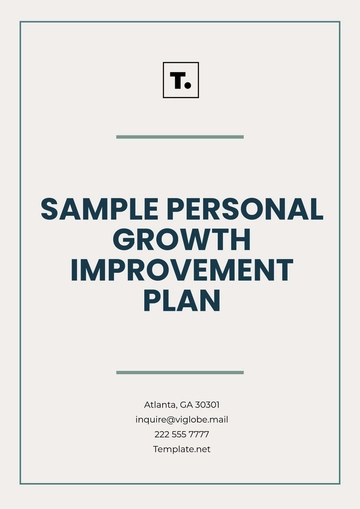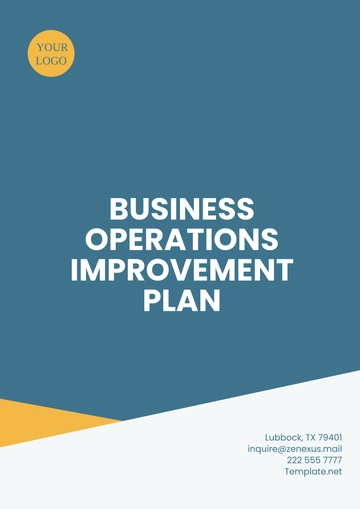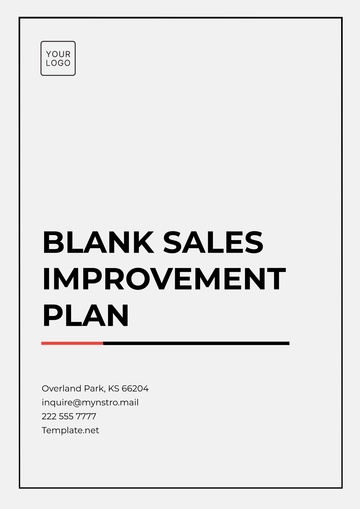Free Team Collaboration Improvement Plan

Prepared by:
[YOUR NAME]
[YOUR COMPANY NAME]
1. Introduction
The purpose of this plan is to enhance collaboration within the team by addressing key areas such as communication, role clarity, team engagement, and the integration of technology. By fostering a more cohesive and efficient work environment, we aim to improve productivity, streamline workflows, and achieve our collective objectives with greater effectiveness.
2. Objectives
The primary goals of this plan are:
Enhance communication channels: Foster clearer, more consistent communication across all team members.
Establish clear roles and responsibilities: Define and assign specific roles to ensure everyone understands their contributions to the project.
Encourage collaboration through team-building activities: Strengthen interpersonal relationships and create a positive, supportive work environment.
Utilize technology to streamline processes: Integrate project management and communication tools to improve efficiency and accountability.
3. Current Assessment
3.1 Communication Analysis
Through surveys and team meetings, we have identified several gaps in our current communication practices. The feedback revealed issues such as unclear information dissemination, delays in sharing updates, and a lack of standard communication protocols. These gaps have sometimes led to misunderstandings and delays in project progress.
3.2 Team Dynamics
Our team exhibits a strong willingness to collaborate, but there are areas where we can improve in understanding and leveraging each other’s work styles. Some team members tend to work independently, while others prefer more frequent collaboration. By aligning expectations and promoting mutual understanding of individual strengths and preferences, we can enhance overall teamwork.
4. Strategies for Improvement
4.1 Enhancing Communication Channels
To address communication challenges, we will implement the following strategies:
Regular team meetings: Hold bi-weekly meetings to share updates, discuss challenges, and ensure alignment on goals.
Collaborative tools: Introduce platforms like Slack or Microsoft Teams to streamline communication and make information more accessible. All team members will be encouraged to use these tools for quick queries and information sharing.
Clear communication protocols: Establish a communication protocol that outlines when and how to escalate issues, ensuring that important information is conveyed promptly.
4.2 Defining Roles and Responsibilities
Clearly defined roles will reduce ambiguity and improve accountability:
Role chart: Create a team role chart that outlines the responsibilities of each member, making sure each team member understands their contributions to the overall project.
One-on-one check-ins: Schedule regular individual check-ins to address any uncertainties and adjust roles based on team members’ strengths and project needs.
Task ownership: Ensure that each task within a project is assigned to a specific person to avoid overlap and ensure clear accountability.
4.3 Team-Building Activities
To foster collaboration and trust, we will:
Organize team-building activities: Monthly activities such as workshops, problem-solving exercises, and informal team lunches will be scheduled to strengthen relationships and improve team morale.
Feedback loops: Encourage open dialogue about team dynamics during team-building sessions to identify any ongoing challenges and address them early.
Recognition programs: Introduce a recognition program to highlight individual and team accomplishments, reinforcing the value of collaboration and positive reinforcement.
4.4 Technological Integration
To improve efficiency, we will adopt tools that support seamless project management and task tracking:
Project management tools: Implement platforms like Trello, Asana, or Monday.com for task assignments, progress tracking, and deadline management.
Training sessions: Provide training for team members to ensure they are proficient in using these tools and maximizing their potential for collaboration.
Workflow standardization: Streamline workflows by documenting best practices and utilizing templates to minimize time spent on repetitive tasks.
5. Implementation Timeline
Phase | Activity | Timeline |
|---|---|---|
Phase 1 | Conduct team meetings and workshops | Weeks 1-2 |
Phase 2 | Implement communication tools (Slack, MS Teams) | Weeks 3-4 |
Phase 3 | Launch team-building programs | Month 2 |
Phase 4 | Review and adjust strategies | Month 3 |
6. Monitoring and Evaluation
The success of this plan will be evaluated through ongoing monitoring of key performance indicators (KPIs):
Team engagement levels: Measured through regular surveys to assess satisfaction, communication effectiveness, and overall collaboration.
Task completion rates: Track the number of tasks completed on time and the reduction of errors or overlaps.
Project success rates: Evaluate the quality of deliverables and the achievement of project goals.
Feedback collection: Gather input from team members on the effectiveness of communication tools, role clarity, and team-building activities, making adjustments as needed.
These KPIs will be reviewed monthly to ensure that the plan is on track and adjustments are made where necessary.
7. Conclusion
By implementing the Team Collaboration Improvement Plan, we are committed to creating a more harmonious and productive team environment. This plan focuses on enhancing communication, clarifying roles, fostering team engagement, and integrating technology to streamline workflows. We believe that these improvements will lead to more efficient project delivery, higher team morale, and a more collaborative work culture, ultimately contributing to the overall success of the team.
- 100% Customizable, free editor
- Access 1 Million+ Templates, photo’s & graphics
- Download or share as a template
- Click and replace photos, graphics, text, backgrounds
- Resize, crop, AI write & more
- Access advanced editor
The Team Collaboration Improvement Plan Template from Template.net is fully editable and customizable to enhance team dynamics and cooperation. Tailor the plan to address specific collaboration challenges and goals. Editable in our AI Editor Tool, this template offers a flexible, personalized approach to fostering effective communication, teamwork, and overall productivity within your organization.
You may also like
- Finance Plan
- Construction Plan
- Sales Plan
- Development Plan
- Career Plan
- Budget Plan
- HR Plan
- Education Plan
- Transition Plan
- Work Plan
- Training Plan
- Communication Plan
- Operation Plan
- Health And Safety Plan
- Strategy Plan
- Professional Development Plan
- Advertising Plan
- Risk Management Plan
- Restaurant Plan
- School Plan
- Nursing Home Patient Care Plan
- Nursing Care Plan
- Plan Event
- Startup Plan
- Social Media Plan
- Staffing Plan
- Annual Plan
- Content Plan
- Payment Plan
- Implementation Plan
- Hotel Plan
- Workout Plan
- Accounting Plan
- Campaign Plan
- Essay Plan
- 30 60 90 Day Plan
- Research Plan
- Recruitment Plan
- 90 Day Plan
- Quarterly Plan
- Emergency Plan
- 5 Year Plan
- Gym Plan
- Personal Plan
- IT and Software Plan
- Treatment Plan
- Real Estate Plan
- Law Firm Plan
- Healthcare Plan
- Improvement Plan
- Media Plan
- 5 Year Business Plan
- Learning Plan
- Marketing Campaign Plan
- Travel Agency Plan
- Cleaning Services Plan
- Interior Design Plan
- Performance Plan
- PR Plan
- Birth Plan
- Life Plan
- SEO Plan
- Disaster Recovery Plan
- Continuity Plan
- Launch Plan
- Legal Plan
- Behavior Plan
- Performance Improvement Plan
- Salon Plan
- Security Plan
- Security Management Plan
- Employee Development Plan
- Quality Plan
- Service Improvement Plan
- Growth Plan
- Incident Response Plan
- Basketball Plan
- Emergency Action Plan
- Product Launch Plan
- Spa Plan
- Employee Training Plan
- Data Analysis Plan
- Employee Action Plan
- Territory Plan
- Audit Plan
- Classroom Plan
- Activity Plan
- Parenting Plan
- Care Plan
- Project Execution Plan
- Exercise Plan
- Internship Plan
- Software Development Plan
- Continuous Improvement Plan
- Leave Plan
- 90 Day Sales Plan
- Advertising Agency Plan
- Employee Transition Plan
- Smart Action Plan
- Workplace Safety Plan
- Behavior Change Plan
- Contingency Plan
- Continuity of Operations Plan
- Health Plan
- Quality Control Plan
- Self Plan
- Sports Development Plan
- Change Management Plan
- Ecommerce Plan
- Personal Financial Plan
- Process Improvement Plan
- 30-60-90 Day Sales Plan
- Crisis Management Plan
- Engagement Plan
- Execution Plan
- Pandemic Plan
- Quality Assurance Plan
- Service Continuity Plan
- Agile Project Plan
- Fundraising Plan
- Job Transition Plan
- Asset Maintenance Plan
- Maintenance Plan
- Software Test Plan
- Staff Training and Development Plan
- 3 Year Plan
- Brand Activation Plan
- Release Plan
- Resource Plan
- Risk Mitigation Plan
- Teacher Plan
- 30 60 90 Day Plan for New Manager
- Food Safety Plan
- Food Truck Plan
- Hiring Plan
- Quality Management Plan
- Wellness Plan
- Behavior Intervention Plan
- Bonus Plan
- Investment Plan
- Maternity Leave Plan
- Pandemic Response Plan
- Succession Planning
- Coaching Plan
- Configuration Management Plan
- Remote Work Plan
- Self Care Plan
- Teaching Plan
- 100-Day Plan
- HACCP Plan
- Student Plan
- Sustainability Plan
- 30 60 90 Day Plan for Interview
- Access Plan
- Site Specific Safety Plan




























